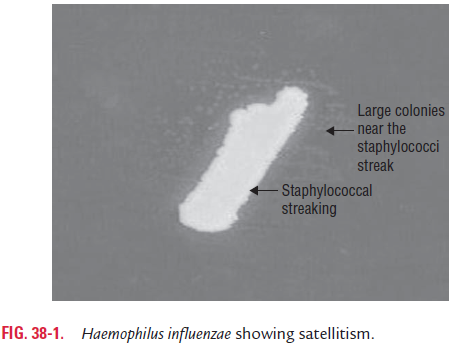Chapter: Microbiology and Immunology: Bacteriology: Haemophilus, Pasteurella, and Actinobacillus
Haemophilus influenza: Properties of the Bacteria
Haemophilus influenza
H. influenzae is the species most commonly associated withhuman disease. It is an important cause of meningitis in chil-dren and also of respiratory tract infection in children as well as in adults.
Properties of the Bacteria
◗ Morphology
H. influenzae is a small, pleomorphic, Gram-negative bacillus.It measures 1 3 0.3 mm. In fresh cultures, the bacteria are usu-ally coccobacilli, while in older cultures, long filamentous forms are seen. The bacteria are nonmotile, nonsporing, and nonacid fast. Some strains of H. influenzae possess polysaccharides cap-sule. The capsule can be detected by India ink preparation or by capsular swelling reaction using type-specific antiserum.
◗ Culture
H. influenzae is a fastidious bacterium. It is facultative anaerobe,grows better in anaerobic condition. The optimal temperature is 35–37°C. They do not grow below 22°C. Presence of 5–10% CO2 enhances the growth of the bacteria.
Growth factors: H. influenzaerequires two erythrocytic growthfactors, X factor and V factor. These factors are released follow-ing lysis of blood cells, thereby allowing growth of fastidious H. influenzae on the chocolate agar. H. influenzae cannot growon nutrient agar, because it lacks these growth factors.
X factor: It is a heat-stable factor present in blood. It is aprotoporphyrin IX, hemin, or other iron-containing porphyrin. X factor is required for the synthesis of iron-containing bacterial enzymes, such as catalase, cytochrome oxidase, and peroxidase.
V factor: It is a heat-labile factor present in red blood cells andin other animal and plant cells. This factor is destroyed at 120°C in 30 minutes. This factor is also synthesized by Staphylococcusaureus and also by some fungi. Earlier this factor was thoughtto be a vitamin, hence was named V factor. This has now been identified as NAD or NADP coenzyme I. The V factor appears to act as hydrogen acceptor in oxidation–reduction process in a replicating bacterial cell. H. influenzae produces large colonies on the blood or chocolate agar by any of the following methods:
· Chocolate agar: V factor is released from erythrocytes by heat-ing blood agar at 80–90°C in order to prepare chocolate agar. The released V factor from the erythrocytes supple-ments the growth of colonies.
· By using S. aureus as source of V factor: V factor is produced bystaphylococci; hence growth on blood agar can be promoted by providing S. aureus as source of V factor. Blood agar with S. aureus streak is routinely used for culture and identifica-tion of H. influenzae. In this procedure, a suspected isolate of H. influenzae is streaked on a blood agar plate. Then S. aureus is streaked across the same blood agar plate and incubated at 37°C for 18–24 hours. After incubation, the colonies of H. influenzae nearer to the S. aureus are larger than those awayfrom it. This phenomenon is known as satellitism. This dem-onstrates that V factor is available in increased concentra-tion near the staphylococcal colony and in a lower concen-tration away from it (Fig. 38-1, Color Photo 40).

Fildes’ agar or Levinthal’s agar are clear and transparent media used for primary isolation and culture of H. influenzae. These are prepared by boiling and filtering a mixture of blood and nutrient broth (Levinthal’s agar) or by adding a peptic digest of blood to nutrient agar (Fildes’ agar).
The capsulated strains of H. influenzae produce larger, 1–3-mm diameter, high convex, and mucoid colonies on the media containing blood (chocolate agar, Fildes’ agar, or Levinthal’s agar) or supplemented with V factors (blood agar
Capsulated strains of H. influenzae pro-duce translucent colonies with a conspicuous iridescence on Levinthal’s agar. Fildes’ agar is used best for primary isola-tion of H. influenzae. In contrast, on these media, noncapsu-lated strains produce relatively smaller, low convex, smooth, and transparent colonies.
Chocolate agar containing penicillin and bacitracin is usu-ally used for isolation of H. influenzae from clinical specimens, which consist of normal bacterial flora.
Growth of H. influenzae on ordinary blood agar is scanty and the colonies are small because the V factor is not freely available being found inside the red blood cells. H. influenzae does not produce any hemolysis on blood agar.
Variations: H. influenzaecolonies show a smooth to rough vari-ation associated with loss of capsular antigen and subsequent loss of virulence. The genetic characteristics of capsular antigen and antibiotic resistance can be transformed. Nonencapsulated strains of H. influenzae can become capsulated by transfer of genetic matter that codes for the capsule.
◗ Biochemical reactions
H. influenzae shows the following biochemical reactions:
· It is catalase and oxidase positive.
· It ferments glucose and galactose, but does not ferment lac-tose, sucrose, and mannitol.
· It reduces nitrates to nitrites.
◗ Other properties
Susceptibility to physical and chemical agents: H. influenzaeis a delicate bacillus. It is readily killed within 30 minutes by moist heat at 55°C. It dies within a few days at 4°C as well as in culture plates and dies in less than 2 days in dried clinical secre-tions. Bacteria are sensitive to commonly used disinfectants and also to desiccation. Cultures are difficult to maintain due to autolysis. Cultures may be preserved by frequent subcultures on chocolate agar. Lyophilization is a good method for long-term preservation ofH. influenzae culture.
Related Topics